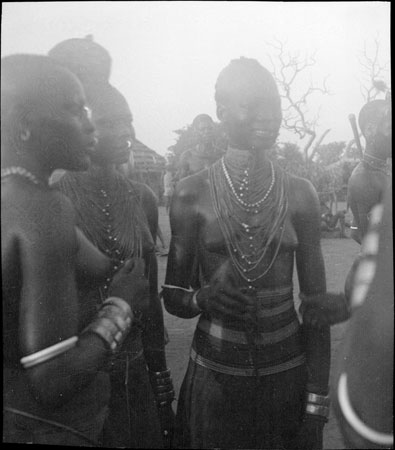Mandari girl wearing bead ornaments

46 x 40 mm | Negative film nitrate
Date of Print:
Unknown
Previous PRM Number:
JB.2.6
Accession Number:
1998.97.21
Description:
An upper body portrait of a Mandari girl wearing a large number of beads around her neck and waist, with other girls in a group surrounding her also wearing decorative neck and arm ornaments.
Girls wore a number of different ornaments for decorative purposes, often given to them by a favourite youth who was courting them.
There was reciprocity in matters of adornment, with girls likewise gifting youths with items for display.
This girl might be wearing the beads of a favourite youth around the waist, indicating the age set and status of her admirer, although girls had no age sets of their own.
Her hair is styled in a similar manner to the youths.
Photographer:
Jean Carlile Buxton
Date of Photo:
1950 - 1952
Region:
[Southern Sudan] Bahr el Jebel Tali
Group:
Mandari
PRM Source:
Ronald Carlile Buxton via Institute of Social and Cultural Anthropology
Acquired:
Donated 1988
Other Owners:
Jean Buxton Collection
Class:
Ornament , Toilet
Keyword:
Ornament Neck , Hair , Ornament Arm
Documentation:
See Related Documents File. Buxton field notebooks in Tylor Library.
Other Information:
In Some Notes on the Mandari of Equatoria Province, A.E.
Sudan, (typescript notebook of c.1951 in Tylor Library, Institute of Social and Cultural Anthropology, University of Oxford), book I, page 33,35, Jean Buxton notes that 'As with the youths, girls wear a large number of necklaces, bracelets, arm bands and ear rings.
There is a good deal of reciprocity between the sexes in matters of decorations; a girl will give small tokens to a lover or favourite.
In the same way a beautiful girl will always be well supplied with trinkets...The old Mandari marking was a triple row of small dots above the eyes and across the forehead, which was sometimes continued in a curve round the eye sockets and on the cheek bones...but which has been replaced among the younger Mandari by the long radiating cuts of the Dinka.
These marks are common to men and women, and, unlike those done in the Dinka tribes, have nothing to do with initiation, nor have they any ritual or social significance apart from decoration.' [Chris Morton 2/11/2004] The edges of this neagtive have been heavily cropped [Chris Morton 2/11/2004]
Recorder:
Christopher Morton 2/11/2004 [Southern Sudan Project]

